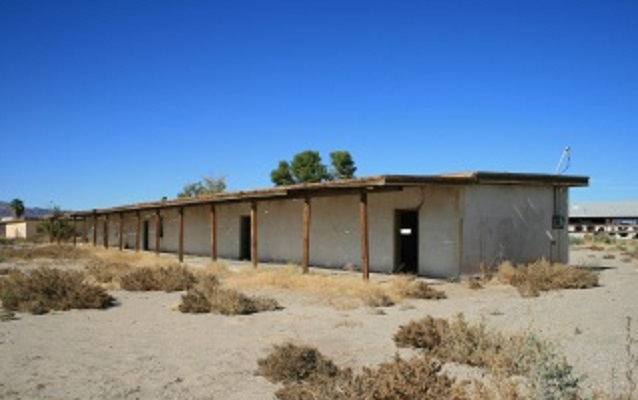Last updated: March 11, 2019
Place
Poston Elementary School, Unit 1, Colorado River Relocation Center

Courtesy of the Library of Congress.
Poston Elementary School, Unit I at the Poston Relocation Center (also known as the Colorado River Relocation Center) is the only example of a separate elementary school complex built within a Japanese American relocation center during World War II. Also located in the area are assorted other buildings and portions of two irrigation ditches detainees helped construct as part of the irrigation system at the relocation center. Unit 1, the location of the elementary school complex, was the largest of the three areas at the Poston Relocation Center, and the Poston Elementary School complex is the largest, most intact, and most cohesive collection of buildings still standing at Poston.
After Japan's attack on Pearl Harbor on December 7, 1941, leading to the United States' entry into World War II, President Franklin D. Roosevelt signed Executive Order 9066 on February 19, 1942. The Order authorized the establishment of military areas encompassing most of the West Coast of the United States, "from which any or all persons may be excluded." This allowed for the removal from these areas of Japanese Americans and those of Japanese descent. This was done out of fear that they might support Japan in the war. In March 1942, President Roosevelt signed Executive Order 9102, which established the War Relocation Authority, the federal agency responsible for the evacuation, relocation, and internment of Japanese Americans and the construction and administration of relocation centers throughout the U.S. The U.S. military supported Executive Order 9066 by assembling and transporting the evacuees. Through Executive Order 9066 came Proclamation No.1, which was initially a policy of voluntary participation to relocate; however, the relocation soon became mandatory forcing some 120,000 Japanese Americans and those of Japanese ancestry to move to 10 inland war relocation centers across the nation.
The Poston Elementary School symbolized the desire of the Poston Relocation Center residents to continue their children's education while interned. Both Caucasian and Japanese staff worked at the school, but it struggled with teacher retention. When it opened, the school lacked basic supplies as well as heat during the winter. School conditions gradually improved, and some students graduated and went on to college. Japanese American students attended the Poston schools until the closure of the Poston Relocation Center in 1945. From 1949 to 1980, the Colorado River Indian Tribes and the local school district utilized the Poston I Elementary School buildings which functioned as a community center.
Today, most of the land around the relocation center is irrigated farm fields. Visitors can see a memorial monument erected to mark the site of the relocation center, the existing Poston Elementary School complex, ruins of the associated auditorium, a machine shop, and portions of four other buildings. In addition, the sewage treatment plants at Poston Units I, II, and III are intact. Although many of the approximately 1,900 buildings constructed at the Poston Relocation Center are gone, remnants of foundations or slabs remain at all three units. In addition, a Memorial Monument dedicated to the internees marks the location of the relocation center. The detainee-built irrigation system is still in use and many buildings that were moved from the relocation center are used as utility buildings in the surrounding community.
Poston Elementary School, Unit I, a National Historic Landmark, is located on the Colorado River Indian Tribes Reservation at 26600 Mohave Road in Parker, AZ. For more information, visit the Colorado Indian Tribe's tourism website.
